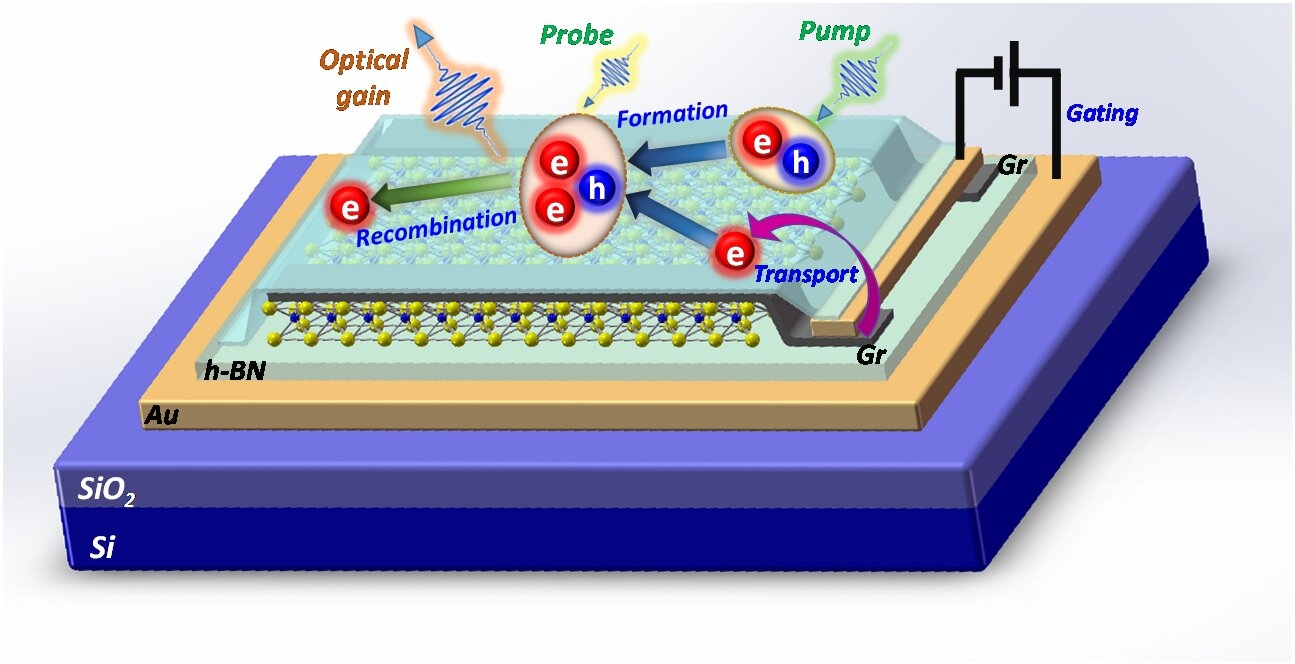News: Optoelectronics
21 May 2020
Excitonic complexes in 2D semiconductors exploited to achieve optical gain
Led by associate professor Hao Sun of China’s Tsinghua University, Cun-Zheng Ning, a professor of electrical engineering in the Ira A. Fulton Schools of Engineering at Arizona State University (ASU), and his peers have explored the intricate balance of physics that governs how electrons, holes, excitons and trions coexist and mutually convert into each other to produce optical gain (Zhen Wang et al, ‘Excitonic complexes and optical gain in two-dimensional molybdenum ditelluride well below the Mott transition’, Light: Science and Applications, 9, article no.39).
“While studying the fundamental optical processes of how a trion can emit a photon or absorb a photon, we discovered that optical gain can exist when we have sufficient trion population,” Ning says. “Furthermore, the threshold value for the existence of such optical gain can be arbitrarily small, only limited by our measurement system.”
In Ning’s experiment, the team measured optical gain at density levels four to five orders of magnitude smaller than those in conventional semiconductors.

Picture: A single layer of 2D material was placed on a substrate with gold as a back-gate to control the number of electrons in the material. Another laser pumps the 2D material to create excitons, some of which form trions with the pre-existing electrons. Reflected light is monitored to find the signature of amplification. Graphic courtesy of Cun-Zheng Ning.
Ning was driven to make such a discovery by his interest in the phenomenon of Mott transitions, an unresolved mystery in physics about how excitons form trions and conduct electricity in semiconductor materials to the point that they reach the Mott density (the point at which a semiconductor changes from an insulator to a conductor and optical gain first occurs). But the electrical power needed to achieve Mott transition and density is far more than what is desirable for the future of efficient computing. Without new low-power nanolaser capabilities like those he is researching, Ning says it would take a small power station to operate one supercomputer.
“If optical gain can be achieved with excitonic complexes below the Mott transition, at low levels of power input, future amplifiers and lasers could be made that would require a small amount of driving power,” Ning says.
It is reckoned that this development could be game-changing for energy-efficient photonics, or light-based devices, and provide an alternative to conventional semiconductors, which are limited in their ability to create and maintain enough excitons.
As Ning observed in previous experiments with 2D materials, it is possible to achieve optical gain earlier than previously believed. Now he and his team have uncovered a mechanism that could make it work.
“Because of the thinness of the materials, electrons and holes attract each other hundreds of times stronger than in conventional semiconductors,” Ning says. “Such strong charge interactions make excitons and trions very stable even at room temperatures.”
This means that the research team could explore the balance of the electrons, holes, excitons and trions as well as control their conversion to achieve optical gain at very low levels of density.
When more electrons are in the trion state than their original electron state, then population inversion occurs. “More photons can be emitted than absorbed, leading to a process called stimulated emission and optical amplification, or gain,” says Ning.
Design of practical 2D nanolasers targeted
While this new discovery added a piece to the puzzle of Mott transitions — uncovering a new mechanism that researchers can exploit to create low-power 2D semiconductor nanolasers — Ning says that they are not yet sure if this is the same mechanism that led to the production of their 2017 nanolasers.
Similar trion experiments were conducted in the 1990s with conventional semiconductors, “but the excitons and trions were so unstable, both experimental observation and, especially, utilization of this optical gain mechanism for real devices is extremely difficult,” Ning says. “Since the excitons and trions are much more stable in the 2D materials, there are new opportunities to make real-world devices out of these observations.”
Ning’s team has more work left to do to study how this new mechanism of optical gain works at different temperatures — and how to use it to create the nanolasers purposefully. “The next step is to design lasers that can operate specifically using the new mechanisms of optical gain,” Ning says.
With the physics foundations laid, they could eventually be applied to create new nanolasers that could change the future of supercomputing and data centers, it is reckoned. “The long-term dream is to combine lasers and electronic devices in a single integrated platform, to enable a supercomputer or data center on a chip,” Ning says. “For such future applications, our present semiconductor lasers are still too large to be integrated with electronic devices.”









